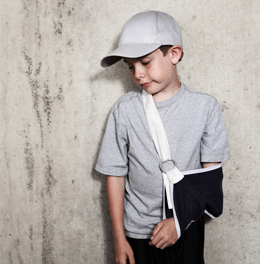
Overuse injuries are becoming more common with today’s young athletes.
For the 44 million U.S. children and adolescents between the ages of 6 and 18 years who participate in organized athletics, youth sports can be both enjoyable and beneficial. However, the increasingly competitive nature of these sports as well as early “single sport specialization,” is leading to overuse injuries and burnout that was once only seen at the high school—or higher—level. The American Society of Sports Medicine (AMSSM) takes the position that these injuries may not only require lengthy recovery periods but can potentially result in long-term health consequences. We spoke to some local medical experts to discuss what they’re seeing in our region.
The doctors in our region concur that this trend of overuse injuries in youth sports is undoubtedly happening here in South Jersey, as it is in the rest of the country. “We’re absolutely seeing this trend—most notably in baseball, but also sometimes soccer or basketball,” says Dr. Enrique J. Garcia Pena, orthopedic surgery and sports medicine, Regional Orthopedic Professional Association in Cherry Hill, and a member of Kennedy Health’s medical staff. “We’re seeing kids playing through pain and being reluctant to take time off.”
One of the most frequent overuse injuries seen in youth sports is shoulder or elbow damage from throwing. Kids who are practicing their pitching year round aren’t resting their arms and are potentially putting themselves at risk for an ulnar collateral ligament (UCL) tear, an injury once only seen in professional sports.
“It’s kind of crazy that we’ve gotten to an age where we’re doing Tommy John surgeries on middle school kids,” says Garcia Pena. “That used to be a surgery only seen at the professional level. I think there’s this belief that surgery is a quick fix, even at the amateur level. But people aren’t thinking about the long-term effects. If kids are having surgery that young, they’ll likely need to have it again—particularly if they realize their dream of making it to a professional level.”
And therein lies a huge part of the problem: While parents, coaches, and even kids themselves are pushing hard to achieve a future in sports, they may actually be hurting their chances by causing damage early on. If a young player gets hurt, they may never perform at the same level again. It can be difficult to come back from an injury and can absolutely have an effect on one’s long-term possibilities.
Defining the problem
One of the biggest causes behind overuse injuries is the single sport specialization which is becoming increasingly common. Kids who get serious about a sport are playing year round. Some may even be participating in more than one league during the same season.
“It used to be that you participated in one sport per season,” says Dr. Mark A. Pollard, assistant professor of orthopedic surgery at Cooper Medical School at Rowan University, specializing in orthopedic sports medicine. “Now you’re seeing this trend of super specialization in a sport. Baseball is a huge culprit with year-round leagues and pitching coaches in the off-season.”
“I’ve seen signs on the side of the road advertising soccer starting as early as 18-months old,” adds Dr. Gregory Klingenstein, an orthopedic surgeon at the Virtua Joint Replacement Institute and with Reconstructive Orthopedics, which has offices throughout South Jersey. “Kids are not only starting at a younger age but more likely to play year round.”
Dr. Gregory J. Goodworth, a diagnostic radiologist with South Jersey Radiology, sees these patients at the time of injury, when they come in for imaging. He says that with overuse injuries it’s almost primarily joint trouble. That includes a lot of ankles, elbows, hips and shoulders.
“Oftentimes these kinds of overuse injuries don’t require imaging from me,” Goodworth says. “Orthopedic doctors already have a good idea of what’s happening. But if a patient presents with pain that can’t be isolated to one structure, ligament, tendon or bone then we’ll do a scan—typically to rule out major pathology like a fracture, bone tumor or an avulsion injury, when a ligament or tendon that is attached to the bone is pulled off, possibly pulling the bone with it. These are all much more serious injuries.”
Typically, overuse injuries present with pain—sometimes also swelling. When that happens, parents and coaches should have the child rest and stay out of the game for a week to 10 days. If pain persists, it may be time to see an orthopedic specialist. While an injury is usually obvious to parents and coaches, Dr. John Gray, co-director of the Sports Medicine Program at Virtua as well as a practicing physician with Reconstructive Orthopedics, adds that there can be some less-obvious red flags that there’s pain.
“Most of the time a child will be forthcoming about their pain but if they are no longer interested in their sport and are performing at a different level, these are also red flags that there may be an injury,” he says. “My general recommendation to prevent these kind of overuse injuries is to try different sports in different seasons.
Avoid that overspecialization—particularly at such a young age. Even if you are going to go after one sport, take a month or two off, twice a year. Even the professional athletes take time off.”
Time to rest
Gray says that part of the solution may be better educating parents, coaches, and athletes on the importance of rest.
“There’s so much pressure to constantly be out in the field but ultimately a child will perform better if they get that rest time in,” he says. “If they have a serious injury and hurt their growth plate or tendon, they can also hurt their chances of performing at a higher level.”
It’s also important to recognize that while these types of injuries are almost always assumed to be associated with team sports, dance and gymnastics are common culprits as well.
“Children who participate in dance or gymnastics at a high competitive level are just as likely to have these kind of overuse injuries,” says Klingenstein. “I will see one of these patients after an injury and ask them if they’ve tried resting. They may say they took two days off. That’s simply not enough. Rest is usually the best answer for these kinds of injuries—the challenge is getting the patient to do it.”
Considering the long-term consequences may be the best shot at compliance.
“You always have to think about the long-term consequences,” says Dr. Larry Deutsch, a board-certified orthopedic spine surgeon with Coastal Spine, which has a main office in Mount Laurel. “When you have a kid that really loves a sport and is doing exceptionally well, it’s easy to get caught up thinking about scholarships and maybe even a professional career. But that’s the short-term future. We all have the potential to live 100 years. The long-term future could be filled with grief, such as arthritis at an earlier age, because of pushing the body way too hard.”
“It can be hard to tell a parent or their child that they need to slow down,” Pollard admits. “But the long-term consequences can be serious and that’s what needs to be considered. Kids should not be playing through pain.”
Published (and copyrighted) in South Jersey Magazine, Volume 12, Issue 3 (June, 2015).
For more info on South Jersey Magazine, click here.
To subscribe to South Jersey Magazine, click here.
To advertise in South Jersey Magazine, click here.












